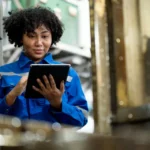A Butterfly-Inspired Design to Create Crumple-Recoverable Electronics
Over the past decades, electronics engineers have created devices of various shapes and with increasingly sophisticated designs. This includes electronics that can be folded onto themselves, such as foldable phones, along with various other compressible devices.
Inspiration from Nature
Researchers at Ajou University and other institutes in South Korea recently introduced a new Design for developing crumple-recoverable electronics, or in other words, electronics that can recover their original shape after being crumpled or compressed onto themselves to reduce their size.
This design, outlined in a paper published in Nature Electronics, draws inspiration from the mechanism that allows butterflies to unfold their wings when leaving their Cocoon.
“Nature is rich of different plants and animals, each of which survived by adapting and evolving in extreme environments,” Seungyong Han, co-author of the paper, told Tech Xplore.
“Personally, I’ve always thought that by closely observing these phenomena, we can find clues to solve various problems in modern society. Also, by approaching this from an Engineering perspective, I believed we could achieve results that may improve people’s daily lives.”
Natural Wing-Unfolding Mechanism
Before a butterfly is born, its wings are folded and crumpled onto themselves inside a Cocoon. Notably, inside the Cocoon, the wings are wet with a biological fluid, which prevents them from being damaged while they are still crumpled.
When a butterfly emerges from its Cocoon, the fluid evaporates, allowing it to slowly unfold its wings, leading to the dissipation of the wrinkles they exhibited while folded.
Han and his colleagues set out to create a Design for electronics inspired by this natural wing-unfolding mechanism. To do this, they first created a composite material with variable stiffness.
The Design Proposed
The hardness and softness of this material can be controlled without requiring additional substances. This makes it promising for the development of flexible and sturdy electronics that do not exhibit wrinkles, even after they are crumpled.
“Our crumple-recoverable electronics are designed to mimic the remarkable properties of butterfly wings, which can be crumpled in a chrysalis and then emerge smooth and functional,” Han explained.
“Their core underlying Design integrates silver nanowires, a shape memory polymer (SMP), and an elastomer. The silver nanowires are not only conductive but also act as mechanical sensing elements. They help in changing the phase of the SMP through Joule heating, which is a process of heating a material using an electric current.”
How It Works
The Design proposed by this research team works as follows: when an electronic device is crumpled, the SMP (a flexible material) it contains allows it to fold without exhibiting permanent damage. If heat is applied to this material via a series of silver nanowires, it transforms and becomes rigid.
“This change helps the electronics to unfold and regain their original, flat shape without any permanent wrinkles or damage,” Han said. “Devices created using our Design can withstand being crumpled and unfolded repeatedly without losing functionality. Our Design also results in a high packing efficiency, allowing devices to be compressed into very small spaces (like a 1 ml capsule) and then expanded back to their original size.”
Advantages of the Design
The unique Design introduced by Han and his colleagues has several advantageous characteristics. Firstly, it allows users to easily modulate the stiffness of devices depending on their needs.
“After being crumpled, the devices can return to their original shape and functionality, a property inspired by nature,” Han said.
To demonstrate their Design, the researchers have so far used it to create a 7 cm-by-7 cm touch panel display. They showed that this display can be crumpled into a tiny capsule and subsequently unfolded, becoming a smooth and flat surface that can detect touch.
“In essence, our crumple-recoverable electronics blend the resilience of natural systems with the precision of modern technology, offering a novel approach to designing flexible and durable electronic devices,” Han said.
Future Applications
Most previously developed shape-changing devices are based on foldable structures that fold in precise places and by repeating similar movements. Over time, these devices can deteriorate, for instance producing wrinkles, creases, or structural damage at the sites where they fold onto themselves.
“Our research can solve these problems, thus potentially contributing directly to the development of customizable shape-changing electronic devices,” Han said. “The electronic devices we developed can also be applied to touch panels or displays. They are likely to be particularly useful in wearable technology and robotics because of their ability to change shape and their flexible nature, making them suitable for any field requiring interaction with the human body.”
Wide Range of Applications
The crumple-recoverable electronics Design devised by Han and his colleagues could prove valuable for a wide range of applications. In addition to aiding the development of shape-changing robots, adaptable wearable electronics, and compressible displays, it could be used to create self-healing materials for advanced medical and engineering applications.
“An important point to note is that self-healing materials are still in the early stages of development,” Han said. “There are many opportunities in the process of finding where and for what purpose these developed materials can be applied. The difference between our self-healing electronic device and existing self-healing materials is that while previous materials focused on recovering their original shape, our self-healing electronic devices focus on customizable ‘shape change’ and maintaining functionality and adaptation after transformation.”
Future Developments
Han and his colleagues are now trying to use their Design to create various electronics that could subsequently be commercialized. They are currently working on a display integrating a light-emitting layer and touch panels, which could be crumpled and reduced in size without forming any wrinkles or compromising its capabilities.
“With the development of PLEDs, or polymer-based diodes, we are focusing on creating displays that can flexibly change their shape by merging this technology with our own,” Han added. “Considering the ongoing development of foldable phones by various global corporations, we are also contemplating further development of our technology to make it applicable for various modules needed in these devices. This would provide practical convenience in everyday life, aligning with the evolving needs of modern electronics.”
Closing Thoughts
The butterfly-inspired Design for crumple-recoverable electronics is a groundbreaking innovation that combines the resilience of natural systems with the precision of modern technology. This innovation has the potential to revolutionize flexible and durable electronic devices, making them suitable for a wide array of applications.
With ongoing developments and future commercialization plans, the impact of this Design on various fields, from wearable technology to medical and engineering applications, is expected to be profound, offering practical convenience and addressing the evolving needs of modern electronics.
Source: phys








No Comments